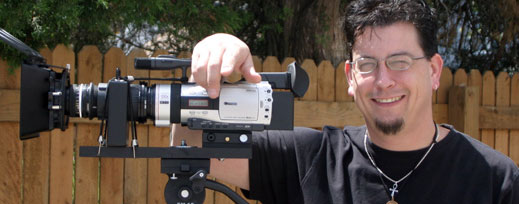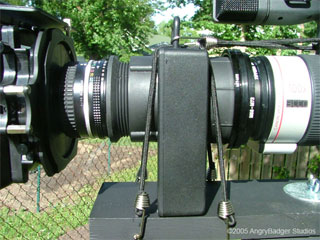

In this installment, we talk with Brett A. Noe, one of the first to complete his adapter using the the Redrock Do-It-Yourself (DIY) Guide. You can find Brett moderating the DIY forums at redrockmicro.com/forum.

1. Tell us a little about you, your background, and how you got into filmmaking
I'm 36, and was in IT for about 10 years. About a year and a half ago, I moved into the video department as a change to save my sanity. It didn't work, but did get me completely hooked on video and film. after a lot of reading and studying, I became fascinated with the idea of being a filmmaker. I'm working on a script for my first feature. I figured if I'm making a movie, it should be the kind of movie I like. It's going to be an action/comedy. Something with a high EPM (Explosions Per Minute) count.
2. Why the name “AngryBadger Studios”?
That's kind of odd really. I used a random name generator. :-) I created a ten name list, and passed it around the office. AngryBadger tied for first. Then, a graphic designer in the office said he had some ideas for AngryBadger. I went with that and he created me a logo. You have to admit, it looks pretty cool!3. Tell us about your filmmaking equipment
I have a Canon GL2 with the Redrock DIY . I have three lenses for it; a 24mm, a 50mm, and a 135mm. All my lenses are primes. I might add a zoom for special effect later, but for now, the primes will do. A 1250W light kit, the Davis & Sanford FM-18 tripod, a home built camera stabilizer, my computer, and the ideas in my head.4. What lead you to decide to explore a 35mm adapter for your video camera?
When I got my first video camera (a Samsung Hi-8), I decided it needed to be more stable, the crawling around the web led me to more info about other aspects of making my movies more "filmic". After looking at a number of options, I saw James' thread on dvinfo.net.5. Why did you choose the Redrock DIY Guide?
James was the first person to produce a guide with a systematic and detailed set of instructions for building such a device. Though I a pretty good tinkerer, I'm also impatient. Using James' plans and a few tweaks, I have a really sweet adapter!6. You developed your own adapter using the Redrock DIY Guide as a reference. Tell us about how long it took, your approach, what worked, and what didn’t.
 It took about 4 weeks for the initial build. The first two weeks were mostly cutting, painting, and planning. I made a couple of modifications to the adapter. One was a CD motor mount idea posted on the forum by Dana Jan. The other was a mod for using a metal Nikon F mount. I still need to post the info on that. :-[ I really like the Nikkor lenses and this mount is rock solid. I finally made some modifications to allow proper setting of the back focus. It seems to work really well now!
It took about 4 weeks for the initial build. The first two weeks were mostly cutting, painting, and planning. I made a couple of modifications to the adapter. One was a CD motor mount idea posted on the forum by Dana Jan. The other was a mod for using a metal Nikon F mount. I still need to post the info on that. :-[ I really like the Nikkor lenses and this mount is rock solid. I finally made some modifications to allow proper setting of the back focus. It seems to work really well now!7. Where can we see sample footage or pictures of your DIY adapter?
My footage can be gotten to via the Redrock Cinema Lens Adapter forums at http://www.redrockmicro.com/forum/
8. What suggestions would you give current or prospective DIYers?
9. Knowing what you know now, is there anything you would have done differently?
Badgered James more! ;-) Seriously, if I had the money, I'd buy the indie kit in a heartbeat. As it is though, I'm really happy with the way the DIY setup turned out. The money spent on the guide probably save me hundreds of hours of experimentation. Those hours were spent relaxing and not tearing my hair out. Worth every penny.10. Now that you have a 35mm adapter, how has it changed your technical or artistic approach to filmmaking?
I tend to look at things with a better eye to DOF and lighting. Lighting is muy importante with this adapter, as it is with film. I also now pay better attention to what is in front and in back of my subject. Since the universe no longer appears flat, I tend to look for a more pleasing composition like I would using a SLR or a film camera. This might even make my home movies more interesting! :-)